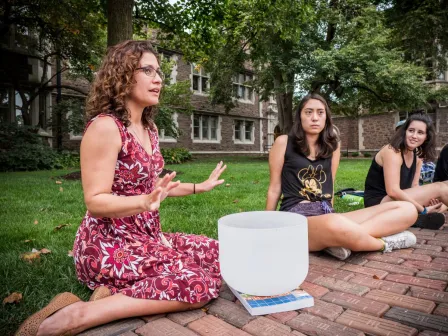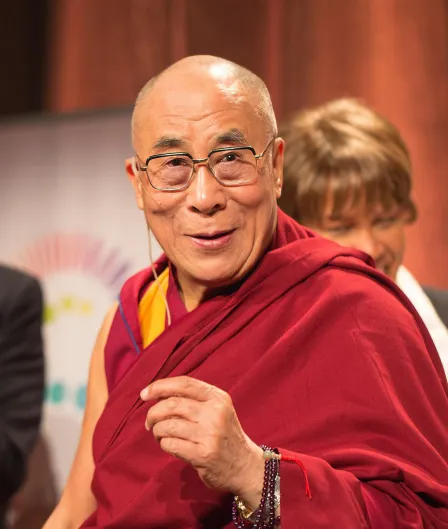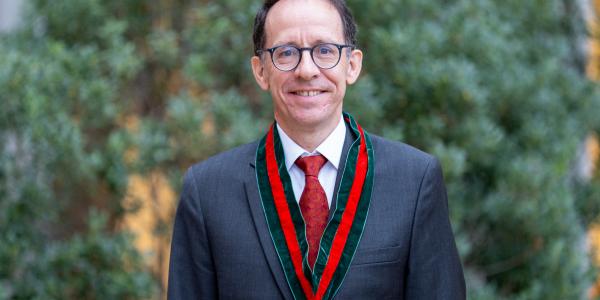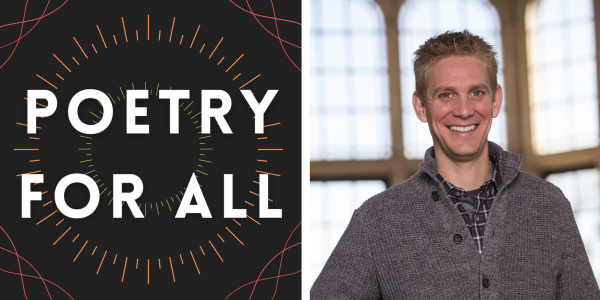This story is part of a 3-part series on mindfulness.
Even though mindfulness is a relatively new area for the social sciences, for Buddhists it has been an important concept for over 2000 years. The term “mindfulness” is a translation of a Pali word sati, which is an integral part of Buddhism. It is the first of the Seven Factors of Enlightenment, and “right” mindfulness is the seventh stop of the Noble Eightfold Path. Specifically, Buddhists use mindfulness to develop self-knowledge and wisdom, in order to eventually achieve enlightenment, or freedom from suffering.

Though Heather Rice is a psychologist by training, she thinks it’s important that the sophomores in her class, “Mindfulness in Psychology and Eastern Philosophies,” recognize the cultural, philosophical, and religious roots of mindfulness practice. “Mindfulness has a much greater religious context than the way it is typically presented at this current time period within the United States,” she says. “For example, meditation was not originally practiced by laypeople. It was only practiced by monastics, those who had devoted their life to Buddhism. They were practicing it much more diligently than what laypeople do today, and it was only one small component of the path to enlightenment. Mindfulness encompasses more than just meditation, and it is only one of eight components of the Noble Eightfold Path that is thought to be path to the cessation of suffering or enlightenment. So, we have to remember that the context from which psychologists take this concept of mindfulness is much greater than what we are studying.”
“There are texts about focusing on different parts of your body and being ‘in’ that part of your body; being fully aware of the sensations there. There are also phrases that talk about focusing on the decomposition of the body. This helps us come to understand that all things are impermanent, which is central to Buddhist thought,” she says. “Each moment is constantly shifting, and that's part of why it is so important to be in the present. One way to do that is by focusing on the impermanence of things, including the impermanence of our bodies. Students often find that thought pretty morose,” she laughs.
Confronting one’s mortality isn’t the first thing that comes to mind when someone mentions mindfulness, and that’s precisely why Rice thinks that students need to understand the greater historical context. In her course, she says students only scratch the surface of the philosophical and religious roots of mindfulness, as it is not her area of expertise. “But I do want them to have an understanding that mindfulness, as studied by psychologists, has been pulled from a much larger set of ideas and beliefs, and we're kind of making it our own.” If you're interested in reading more about what mindfulness is and how one practices it, visit Part I of this series.
“Mindfulness has a much greater religious context than the way it is typically presented at this current time period within the United States.”
Wait, Is This Cultural Appropriation?

Taking a practice and stripping it of its historical and religious context in order to make it more appealing to a new audience sounds a lot like cultural appropriation. Add in a dose of Orientalism, which makes Eastern traditions seem extra mystical to Western audiences, and a dash of capitalism, when mats and yoga clothes are commodified and sold at high prices, and you have a recipe for a potentially troubling trend. Todd Braver, Rice, and their students grapple with this question too.
“In some ways, I think it’s okay that the understanding of mindfulness and its practice are changing; in other ways, I think it's not okay,” admits Rice. “There are religious scholars who are arguing about this as well. In my class, we try to talk about it from more of a psychological standpoint. For example, if you're trying to improve your mental and physiological health, does it really matter if it comes from another culture when it's actually having some benefit? We never really come to any definitive answer in my class, but I think it's an interesting discussion and an interesting problem to grapple with.”
“When I was starting to think about teaching this class, I talked with the then chair of the religious studies department, Beata Grant, who is a Buddhist scholar,” Rice says. “One of the things she wanted to be sure that I impressed upon the class is that there are people who really disagree with making mindfulness a secular sort of practice. In their minds, what Westerners are calling mindfulness isn't actually mindfulness, because it isn't situated within this greater religious or spiritual context.”

This applies too to the research being done with mindfulness. “One aspect of Buddhism is not to harm other people,” Rice says. “But there are researchers who use mindfulness training to help combat soldiers deal with PTSD. Is that really in line with the original Buddhist principles? Is that really using mindfulness in the way that it was intended? There are a lot of people that say that's not appropriate, that it's not mindfulness. It's not Buddhism. There are other people, though that say, if this is a practice that somehow helps people who are suffering in some way, does it matter that it's taken out of context?”
“I'm a psychologist, so I tend more towards the ‘if it helps people, why not use it?’ But I also do understand, if that is your belief system and you're seeing people misuse it, based on your beliefs, that would be seriously problematic,” she says.
At the forefront of mindfulness research, Todd Braver, a professor of neuroscience, radiology, and psychological and brain sciences, wants to be clear that we can’t ignore these religious roots. He thinks one can be interested in the practices for their own sake while also being mindful of what is lost when they are distilled for Western audiences. He says, “I don’t want to devalue any of that, but for myself, I primarily come at it from a scientific perspective. And like anything else, I try to keep myself fit. I exercise to maintain my health. I think it's equally important to practice mental fitness and to take it seriously in the same way. Just as I might go for a run or watch what I eat, I'm also going to try to regulate my thinking and improve my ability to do that.” If you're interested in reading more about how one studies mindfulness and Braver's research, visit Part II of this series.
"If this is a practice that somehow helps people who are suffering... does it matter that it's taken out of context?"
The Dalai Lama’s Take

The Dalai Lama is the spiritual leader of the Tibetan people and a monk of the Gelug or “Yellow Hat” school of Tibetan Buddhism. He represents Buddhist values and traditions, and is the internationally recognized face of Buddhism, as much the Pope is the figurehead for Catholicism. So what does he have to say about the recent explosion of mindfulness research? Actually, he helped fuel it.
Braver has a graph of the scientific papers with “mindfulness” in their title, and it jumps dramatically, skyrocketing from a handful of papers each year in the 70s, 80s, and 90s to hundreds in the 2000s. He says, “We can attribute a lot of this growth to the Dalai Lama himself. In the 1990s, Richard Davidson from the University of Wisconsin-Madison and a few other scientists that were working in this area contacted him, and he was excited to talk to them. He's had a very strong interest in science, and in developing interactions with Western culture around mindfulness."
“Psychology has a long history of primarily being focused on the problems that people have, like depression or impairments or things like that. It's natural,” Braver says. “But the Dalai Lama told them, ‘you could learn a lot from studying people who are successful, who are living happy lives, who experience psychological well-being, to uncover the things that have helped achieve these states.’” From there, the Dalai Lama initiated a series of dialogues with researchers in the early 2000s, resulting in him being invited to give the keynote address at the 2005 Society for Neuroscience meeting, which had 30,000 neuroscientists in attendance from around the world.
"...empirical evidence should triumph over scriptural authority, no matter how deeply venerated a scripture may be.”
–The Dalai Lama
During his speech, the Dalai Lama said, “From the methodological perspective, both [science and Buddhism] emphasize the role of empiricism. For example, in the Buddhist investigative tradition, between the three recognized sources of knowledge—experience, reason and testimony—it is the evidence of the experience that takes precedence, with reason coming second and testimony last. This means that, in the Buddhist investigation of reality, at least in principle, empirical evidence should triumph over scriptural authority, no matter how deeply venerated a scripture may be.”
Braver and other scientists found this encouraging. “I think that is a really strong, important, and courageous message, because most people who are considered to be religious or spiritual leaders don't come out and say, ‘the science should actually be driving what we're practicing and preaching rather than the other way around.’ So I think that was another development that led to the explosion of research we are experiencing—the Dalai Lama saying, ‘Hey, come on, scientists, get involved. Study it carefully. Influence us.’”
A Happy Medium?
The popular concepts around mindfulness have changed dramatically in just a couple decades, and Braver himself has considered how wide this gap between the two camps, religious and scientific, can seem. “It’s funny because, when I first started these practices myself, I was always a little bit wary of saying ‘I meditate’ because I worried that people might think I'm sitting there, wearing beads and in some kind of strange state, doing it for mystical experiences,” he says. “But I just actually got back from a 10-day intensive mindfulness retreat, and it was pretty intense and hard core. I would say it's much more like a boot camp for attention exercises than anything you would think of as being ‘mystical’ or ‘spiritual.’ It was really challenging.”

“It used to be that most people who were experts in mindfulness came from these eastern religious traditions,” Braver says. “Now we're seeing people from a variety of cultures that are approaching mindfulness from a much more practical and pragmatic angle, and not just scientifically. I would describe a couple of groups as ‘pragmatic spiritualists.’ They think about spirituality as leading a meaningful, whole life. You try to gain wisdom and understand what it means to be a good person. I actually think it is possible to do that, and not have to divorce it from science. I think we can study and understand spirituality in ways that are quantifiable, so that we can get more objective indicators of what it means, in practical terms.”
Both Buddhism and psychology are tools for helping us understand ourselves. Buddhism is a technology that’s been around for over 2500 years to help us learn about our minds from the inside out. Western science, over the last 200 years, has taken a third-person perspective to rigorously study people and their brains with objective techniques and measures. Braver thinks the time may be ripe for a marriage between these two approaches.
“If we believe that these first-person methods of watching our own minds at work can give us useful information, then by marrying them with our third-person scientific techniques, maybe we can learn more about minds and brains than is possible with either approach by itself,” he says. “A lot of people are very excited that we might be reaching this period of acceleration, of making rapid strides in what we know, and how we can apply it help people live better lives. To me, that would be a fantastic and important outcome.”
If you're interested in reading more about what mindfulness is and how one practices it, visit Part I of this series. If you're interested in reading more about how one studies mindfulness and Braver's research, visit Part II of this series. Or return to the series homepage.





